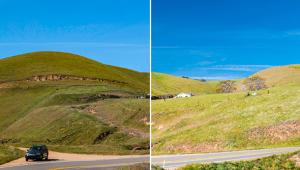Olympus 150mm f2.0 Zuiko Lens
The weather was lousy for the first several days after I received the lens, but I was not able to resist shooting in the early morning and early evening between cloudbursts. It was not what you’d call the ideal shooting environment. Later, of course, I was able to use it under more favorable conditions. But even in the worst light, I was truly amazed.
The 150mm f2.0 is the equivalent of a 300mm f2.0 on a 35mm film camera. I knew that using this glass would be fun, and I expected the results to be superb because it’s one of Olympus’s highest quality (Super High Grade Series) lenses. So I began this adventure with very high expectations—like when you order the signature dish at a famous restaurant. But I was not prepared for this. Holy cats!
This is a worldclass lens. To say it’s sharp is almost an insult—sharp is an adjective reserved for earthly lenses. This glass is from another planet.
To be honest, part of the reason why the performance appears even more extraordinary is a result of the extremely limited depth-of-field that a 300mm lens provides at f2.0. If you want to blur the background and isolate your subject—as in a portrait—there’s no better way to do it than to use a long lens with a large aperture. Separating the main subject from its environment enhances the appearance of sharpness. But physics aside, this glass really cooks.
This lens is no lightweight by any measurement. Tipping the scales at nearly three-and-one-half pounds, it reminds me of a fireplug with a tripod socket. Of course, when a lens is substantially heavier than the camera body to which it’s attached it’s wise to carry the combination by the lens—and carefully, at that. I found it quite comfortable to do so. In fact, the center of gravity provided terrific balance. Between that and Olympus’s in-camera Image Stabilization, I was able to shoot wide open at slow shutter speeds without mishap.
It’s also rather expensive—around $2300 in most shops. But if you consider the fact that you can buy an Olympus DSLR body at a very reasonable price, the combo becomes more attractive. If you shoot stage performances, wildlife, arena sports or anything similar you might find that this lens makes you a suddenly better photographer. And it serves to remind us, once again, that the lens is the most important part of the equation. Oh, the camera body is important, that’s for sure, but if you’ve got worldclass glass you can get good images.
- Log in or register to post comments

















































